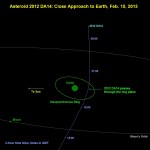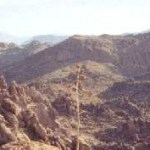Meteor
Earth Impact Calculator
Ok, that was close, and I don't mean the zip by of li'l old 2012 DA14 this evening.
The Chelyabinsk meteor looks to have been on the high end of the range of quick and dirty estimates, with impact energy of maybe 300 kTon equivalent. This is a size impact we'd expect every few decades, maybe, quite a bit smaller than Tunguska, but larger than anything we know of in the last 20 years.
Meteors come in with speeds ranging from 10-70 km/sec.
This one appears to have had a speed of ~ 20 km/sec, which gives it kinetic energy of 2*108 J/kg
As you know, the handy unit here…
“Don't wake me for the end of the world unless it has very good special effects.” -Roger Zelazny
It's always the ones you least expect that get you the worst, it seems. I went to bed last night excited that Asteroid 2012 DA14, a 200,000 ton asteroid, was going to pass within just 28,000 km (or 17,000 miles) of Earth's surface, which would make it the closest pass of an asteroid that large that we've ever observed.
Image credit: NASA / JPL Near-Earth Object Program Office.
I thought that would be the best way to celebrate today, which would be Galileo's 449th birthday. After all, it…
UPDATE: Somebody found a hole in some ice.
This is a meteor streaking across the sky in the vicinity of the Urals:
Numerous additional films of that event and some analysis are on Phil Plait's blog, here.
Here's a FAKE video purported to be a crater formed by a fragment of that meteor BUT IT ISN'T:
From Phil Plait's blog: "Note also lots of hoaxes are turning up, like a video of a flaming crater that's actually a flaming pit in Turkmenistan that's been burning for decades (called "The Door to Hell"). Be cautious and be skeptica"
... apparently the shock wave of the meteor passing over…
"Stuff that's hidden and murky and ambiguous is scary because you don't know what it does." -Jerry Garcia
Earlier this month, one of my favorite musical artist of all-time would have turned seventy. This weekend, I'm off at a fantastic music festival where they're celebrating the life of Jerry Garcia, and in addition to being the leader of the Grateful Dead, he was also a huge influence in the world of bluegrass, americana and folk music. While I always loved his songs about lovable scoundrels, here's a duet of him with David Grisman performing the much more pastoral
Shady Grove,
and…
The Book of Exogenesis: In the beginning was the word, and the word was a meteorite...
Earlier this month, a report, based on NASA studies of meteorites found on Earth, suggested that some building blocks of DNA may have been formed in space.
As it turns out, DNA components have been found on meteorites before, but it's never been entirely clear if the space rocks came to Earth bearing these molecules, or if they were contaminated upon arrival. Furthermore, this recent study of meteorites was the first to discover trace amounts of three molecules -- purine, 2,6-diaminopurine, and 6,8-…
Last year Neatorama's Alex Zavatone happened to find himself near Angola on the African continent. While driving through Grootfontein, Namibia, he spotted a road sign that simply said "Meteorite." Later he decided to make a 170 mile pilgrimage through beautiful and wild landscapes to Hoba to see what it was all about.
You'll have to go to the Neatorama website to see the money shot - but it's worth it! I've never seen such a well-presented interplanetary visitor. Read Alex's full tale here.
Those of you who know me know that I'm unhappy living here in Arizona. The landscape and ecosystem of the Sonoran Desert, while beautiful to many, is too dry, rocky, and devoid of life for me to enjoy living here.
After my time here, I've decided that, were it somehow offered to me, I would probably pass on the opportunity to go to Mars. And so I present to you a little game I call "Mars or Arizona," where I will show you some pictures, and you get to guess which ones are pictures of Mars and which ones are pictures of Arizona. Sound easy?
Well let's bring on the pictures, and see if you…
A close-up B&W shot of the Willamette Meteorite. The holes the riddle one face of the meteorite were not caused by "cosmic collisions" but by the bolide rusting away in the ground prior to its removal from the Oregon soil (it consists of 91% iron).
Virginia Hughes is an editorial assistant here at ScienceBlogs who was especially helpful in moving Laelaps over to it's new home, and now she's brought her excellent writing to The Gist on Smithsonian.com. The first story? A 30-pound hunk of the Willamette Meteorite appraised at $1.3 million was withdrawn from auction after it failed to…



